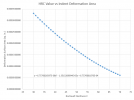Rockwell hardness has a non-linear correlation with yield strength and ultimate tensile strength. However, any curve is straight over a short enough scale, and with the range of hardness used in knives the behavior is effectively linear.
Thanks!
The BladeForums.com 2024 Traditional Knife is available! Price is $250 ea (shipped within CONUS).
Order here: https://www.bladeforums.com/help/2024-traditional/
Rockwell hardness has a non-linear correlation with yield strength and ultimate tensile strength. However, any curve is straight over a short enough scale, and with the range of hardness used in knives the behavior is effectively linear.
Disclaimer: I'm not Larrin. I do not have a PhD in this field and lots of real world experience, I only have a minor and some lab work in an academic setting. However, I would like to expand on his answer a little bit because I found it interesting.Just a question. Is the RC scale linear? We know that higher RC means harder but... how much harder? What does in practical use mean a 2 point harder rating in the RC scale?
I know that RC is a measure of the depth of the indentation created by a device with a diamond tip (either conical or ball shaped) under certain amount of pressure but...I have no idea how the steel behaves under such circumstances.
Sometimes I feel that we start throwing RC ratings arround but might not really understand what it translates into.
Paging LARRIN!
Mikel
 (thumbnail)
(thumbnail)So many average people have SAKs,that are otherwise not knife nuts,and their sharpening skills are usually minimal, so i cant see hardening the steel they use to a point where the average person couldnt touch it up on a ceramic or other sharpening device.
So what do people mean when they say SAK blade steel is "soft" (56 RC rating I believe). Is this compared to modern super steels, or classic carbon steel like 1095? Please educate me as this is somewhat confusing.
